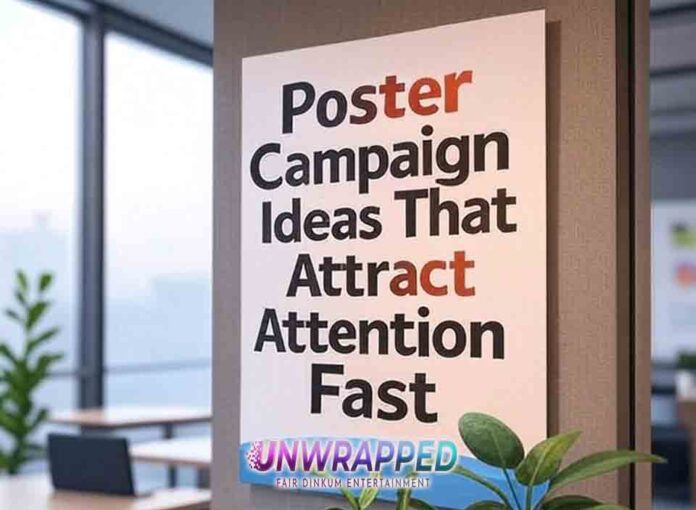Introduction
In today’s fast-paced world, capturing attention quickly is paramount, especially when it comes to marketing and advertising strategies. Posters remain a powerful tool for brands, organizations, and events to convey messages succinctly and visually. However, crafting a poster that stands out in a crowded marketplace requires creativity, strategic thinking, and an understanding of psychological principles.
This guide will explore innovative poster campaign ideas designed to grab attention swiftly and effectively, providing actionable insights that marketers and designers can implement immediately.
Understanding the Psychology of Attention
Before diving into design elements and campaign ideas, it is essential to grasp why certain posters capture attention while others fade into the background. The psychology of attention involves several key principles:
– Salience: People tend to notice what stands out from its surroundings. Unique shapes, sizes, or contrasting elements can enhance salience.
– Emotion: Emotional appeal can significantly increase attention span. Visuals that evoke feelings such as joy, nostalgia, or curiosity often perform better.
– Relevance: Tailoring content to resonate with the target audience’s interests or values can boost engagement levels.
By leveraging these psychological principles, creators can develop posters that not only catch the eye but also resonate deeply with viewers.
Crafting Compelling Visuals
Visual elements are at the heart of any successful poster campaign. Here are some strategies to create compelling visuals:
Bold Imagery
Utilizing high-quality images that align with your message is crucial. Choose images that tell a story or convey emotion without overwhelming the viewer.
Minimalist Design
Less is often more in poster design. A clutter-free layout allows key messages to shine through while making it easier for viewers to absorb information quickly.
Unique Layouts
Experiment with unconventional layouts—diagonal text placement or asymmetrical designs can create visual interest and draw attention.
The Power of Color in Poster Design
Color plays a critical role in how a poster is perceived. Different colors evoke different emotions and associations:
– Red: Excitement, urgency
– Blue: Trust, calmness
– Yellow: Happiness, energy
– Green: Nature, health
When designing a poster, consider the emotional response you wish to elicit and choose your color palette accordingly. Additionally, contrast can be employed to highlight crucial information—dark text on a light background (or vice versa) improves readability.
Engaging Copywriting Techniques
While visuals attract attention, compelling copy retains it. Here are some effective copywriting techniques for posters:
Short and Punchy Headlines
A striking headline should be concise yet powerful. Use strong verbs and intriguing questions to spark curiosity.
Call-to-Action (CTA)
Every poster should have a clear CTA—whether it’s “Join Us,” “Learn More,” or “Shop Now.” Make it prominent so viewers know what action to take next.
Storytelling Elements
Incorporate storytelling aspects into your copy by presenting a problem followed by a solution your product or service offers. This narrative approach makes your message relatable.
Innovative Concepts for Poster Campaigns
To stand out in an oversaturated market, consider implementing these creative concepts:
Interactive Posters
Using augmented reality (AR), create posters that come alive when scanned with a smartphone app. This innovative approach engages users actively rather than passively consuming information.
Posters with Texture
Adding physical texture—such as embossed elements or fabric patches—can create a tactile experience that intrigues potential customers.
Thematic Series
Develop a series of posters that share a common theme but vary in design or messaging. This approach encourages viewers to seek out every piece in the collection.
Utilizing QR Codes and Technology
Integrating technology into poster campaigns can enhance engagement significantly:
– QR Codes: These codes can link directly to additional content—videos, websites, or social media pages—making it easy for viewers to learn more.
– NFC Tags: Near Field Communication (NFC) tags allow users to tap their smartphones on the poster for instant information access.
By incorporating these elements into your design, you provide an interactive experience that can amplify the effectiveness of your campaign.
Case Studies: Successful Poster Campaigns
Examining successful campaigns provides valuable insights into effective strategies:
Nike’s “Just Do It” Campaign
Nike’s iconic slogan paired with dynamic imagery has made its posters instantly recognizable worldwide. The combination of motivational phrases with high-energy visuals has consistently drawn attention and inspired action among consumers.
The World Wildlife Fund (WWF)
WWF employs striking visuals of endangered species alongside poignant messages about conservation efforts. Their use of stark contrasts between vibrant animal imagery and muted backgrounds effectively emphasizes their cause while engaging viewers’ emotions.
These examples illustrate how powerful visuals combined with meaningful messaging can lead to successful outcomes in poster campaigns.
Measuring Success: Metrics for Evaluation
Once your poster campaign is launched, measuring its effectiveness is crucial:
– Engagement Rates: Track how many people interacted with QR codes or visited your website after seeing the poster.
– Surveys: Conduct surveys before and after the campaign to measure awareness levels regarding your brand or message among your target audience.
– Sales Figures: Monitor changes in sales numbers during and after the campaign period to assess direct impact.
Leveraging these metrics will help refine future campaigns based on data-driven insights.
Tips for Distribution and Placement
To maximize visibility for your posters, consider these distribution strategies:
Targeted Locations
Place posters where your target audience frequents—coffee shops for students or gyms for fitness enthusiasts—to increase relevance.
Timing Matters
Launch campaigns during peak times related to your event or product release (e.g., holidays or local events) when foot traffic is higher.
Collaborations
Partnering with local businesses can expand reach; displaying posters in complementary venues allows both brands to benefit from increased exposure.
As you implement these strategies, remain adaptable—monitoring performance metrics will allow you to pivot as necessary for optimal results.
By adopting these comprehensive strategies and innovative ideas outlined above, businesses can create impactful poster campaigns that not only attract attention quickly but also foster lasting connections with their audience.










